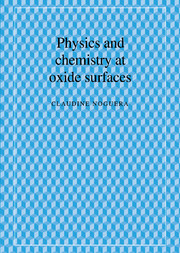Preface
Published online by Cambridge University Press: 24 September 2009
Summary
Although oxides have been the subject of active research for many years, they have attracted an increasing interest in the last decade. One reason for this interest is the discovery of superconductivity in copper oxide based materials, in 1986, with critical temperatures higher than the temperature of liquid nitrogen. Simple oxides have also been more thoroughly studied and a detailed analysis of their surface properties has been undertaken, thanks to several technological advances made during this period. The success in compensating charging effects, for example, has allowed spectroscopic measurements to be performed. Photoemission, x-ray absorption, Auger spectroscopy and low-energy electron diffraction now yield quantitative information, as they do for semi-conductors and metals. Topographic images of insulating surfaces can be recorded with an atomic force microscope. On the theoretical side, advanced numerical codes have been developed, which solve the electronic structure, optimize the geometry, and start accounting for dynamical effects in an ab initio way. The results presently available allow a first synthesis of the field.
The interest and the richness of the field of oxide surfaces lies in its inter-disciplinary nature and in the diversity of questions it raises, both on a fundamental and on an applied level. For example, geophysicists and geologists consider in detail the surface properties and porosity of the rocks of our earth, made of complex oxides whose properties are, to a large extent, controlled by the grain boundaries and internal surfaces.
- Type
- Chapter
- Information
- Physics and Chemistry at Oxide Surfaces , pp. xiii - xviPublisher: Cambridge University PressPrint publication year: 1996

